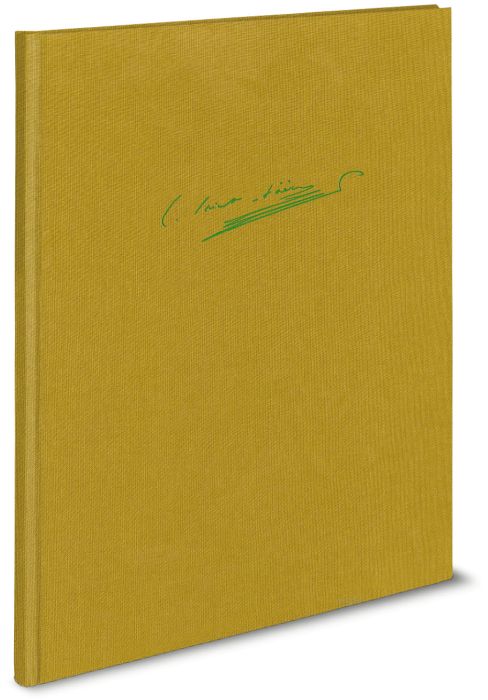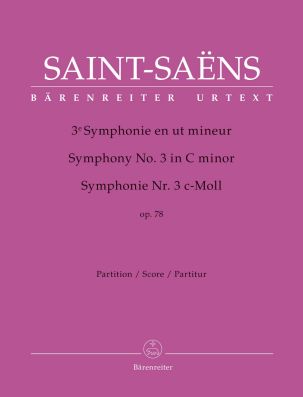Want to be the first to hear latest news and find out about our exclusive promotions.
Sign Up for Our Newsletter:
Symphony No.3 in C minor Op.78 Organ (Full Score, hardback)
Saint-Saëns, Camille
Saint-Saens Symphony No.3 in C minor Op.78 Organ (Full Score, hardback)
The third symphony by Camille Saint-Saëns, known as the Organ Symphony, is the first publication in a complete historical-critical edition of the French composer’s instrumental works.
“I gave everything I was able to give in this work. [...] What I have done here I will never be able to do again.” Camille Saint-Saëns was rightly proud of his third Symphony in C minor Op.78, dedicated to the memory of Franz Liszt. Called the “Organ Symphony” because of its novel scoring, the work was a commission from the Philharmonic Society in London, as was Beethoven’s Ninth, and was premiered there on 19 May 1886. The first performance in Paris followed on 9 January 1887 and confirmed the composer’s reputation as “probably the most significant, and certainly the most independent French symphonist” of his time, as Ludwig Finscher wrote in MGG. In fact the work remains the only one in the history of that genre in France to the present day, composed a good half century after the Symphonie fantastique by Hector Berlioz and a good half century before Olivier Messiaen’s Turangalîla Symphonie.
You would think that such a famous, much-performed and much recorded opus could not hold any more secrets, but far from it: in the first historical-critical edition of the Symphony, numerous inconsistencies and mistakes in the Durand edition in general use until now, have been uncovered and corrected. An examination and evaluation of the sources ranged from two early sketches, now preserved in Paris and Washington (in which the Symphony was still in B minor!) via the autograph manuscript and a set of proofs corrected by Saint-Saëns himself, to the first and subsequent editions of the full score and parts. The versions for piano duet (by Léon Roques) and for two pianos (by the composer himself) were also consulted. Further crucial information was finally found in his extensive correspondence, encompassing thousands of previously unpublished letters. The discoveries made in producing this edition include the fact that at its London premiere, the Symphony probably looked quite different from its present appearance ...
No less exciting than the work itself is the history of its composition and reception, which are described in an extensive foreword. With his Symphony, Saint-Saëns entered right into the dispute which divided French musical life into pro and contra Wagner in the 1880s and 1890s. At the same time, the work succeeded in preserving the balance between tradition and modernism in masterly fashion, as a contemporary critic stated: “The C minor Symphony by Saint-Saëns creates a bridge from the past into the future, from immortal richness to progress, from ideas to their implementation.”
On 19 March 1886 Saint-Saëns wrote to the London Philharmonic Society, which commissioned the work:
“Work on the symphony is in full swing. But I warn you, it will be terrible. Here is the precise instrumentation: 3 flutes / 2 oboes / 1 cor anglais / 2 clarinets / 1 bass clarinet / 2 bassoons / 1 contrabassoon / 2 natural horns / [3 trumpets / Saint-Saëns had forgotten these in his listing.] 2 chromatic horns / 3 trombones / 1 tuba / 3 timpani / organ / 1 piano duet and the strings, of course. Fortunately, there are no harps. Unfortunately it will be difficult. I am doing what I can to mitigate the difficulties.
As in my 4th Concerto [for piano] and my [1st] Violin Sonata [in D minor Op.75] at first glance there appear to be just two parts: the first Allegro and the Adagio, the Scherzo and the Finale, each attacca. This fiendish symphony has crept up by a semitone; it did not want to stay in B minor, and is now in C minor.
It would be a pleasure for me to conduct this symphony. Whether it would be a pleasure for others to hear it? That is the question. It is you who wanted it, I wash my hands of it. I will bring the orchestral parts carefully corrected with me, and if anyone wants to give me a nice rehearsal for the symphony after the full rehearsal, everything will be fine.”
When Saint-Saëns hit upon the idea of adding an organ and a piano to the usual orchestral scoring is not known. The idea of adding an organ part to a secular orchestral work intended for the concert hall was thoroughly novel – and not without controversy. On the other hand, Franz Liszt, whose music Saint-Saëns’ Symphony is so close to, had already demonstrated that the organ could easily be an orchestral instrument in his symphonic poem Hunnenschlacht (1856/57). There was also a model for the piano duet part which Saint-Saëns knew and may possibly have used quite consciously as an exemplar: the “Fantaisie sur la Tempête” from the lyrical monodrama Lélio, ou le retour à la Vie op. 14bis (1831) by Berlioz. The name of the organist at the premiere ist unknown, as, incidentally, was also the case with many of the later performances; the organ part is indeed not soloistic, but should be understood as part of the orchestral texture.
In fact the subsequent success of the symphony seems to have represented a kind of breakthrough for the composer, who was then over 50 years of age. “My dear composer of a famous symphony”, wrote Saint-Saëns’ friend and pupil Gabriel Fauré: “You will never be able to imagine what a pleasure I had last Sunday [at the second performance on 16 January 1887]! And I had the score and did not miss a single note of this Symphony, which will endure much longer than we two, even if we were to join together our two lifespans!”
- Complete Edition of the Instrumental Works Series I/3
- Performance material available for sale from Spring 2017
- In-depth article about the new edition at the online Bärenreiter magzine [t]akte


